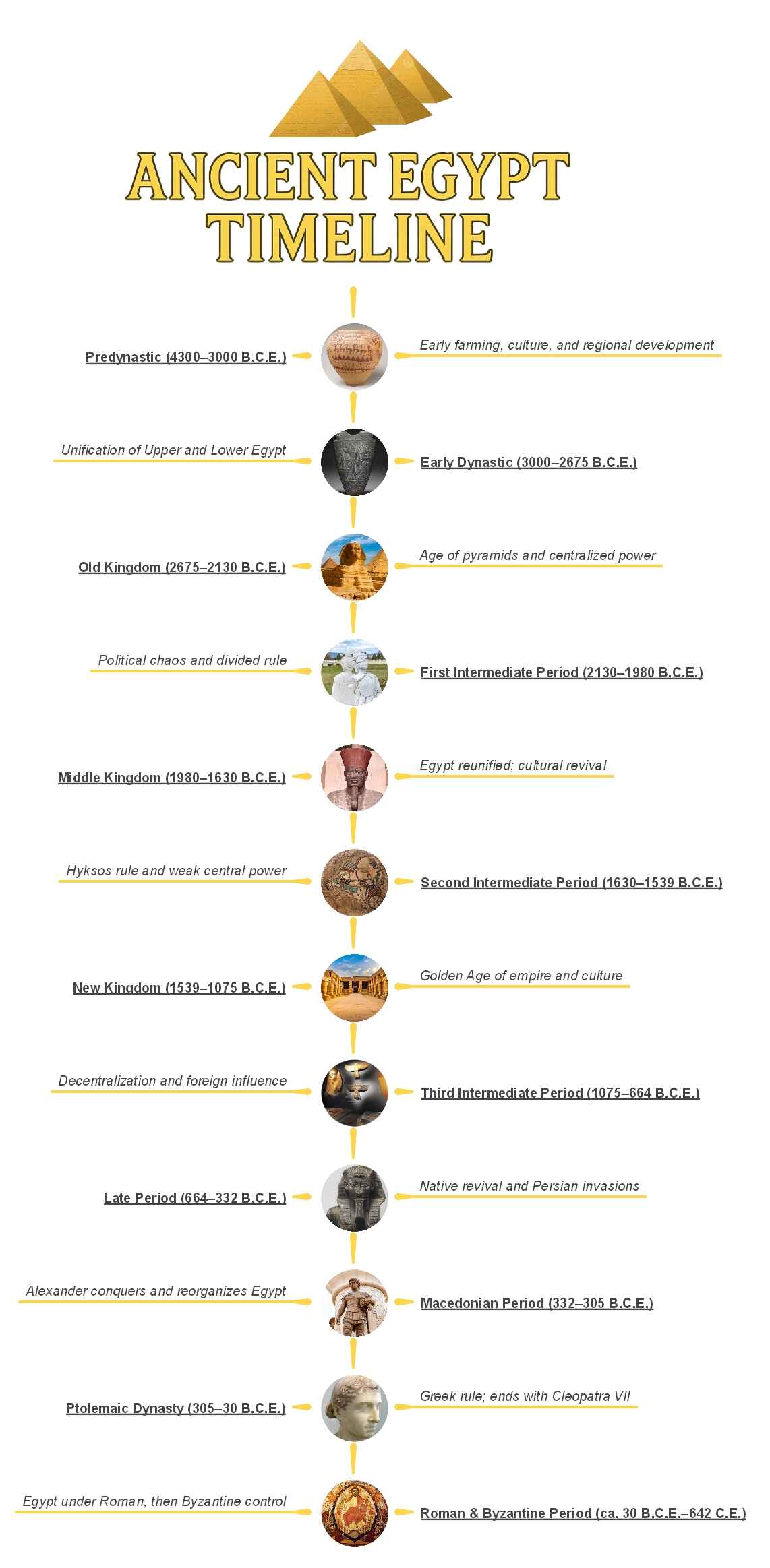Ancient Egypt was one of the most powerful civilizations, which was situated along the Nile in Northeast Africa. It lasted for more than 3000 years. Experts group Ancient Egypt’s history into three kingdoms: the Old, Middle, and New Kingdom.
From 4300 BC to 642 CE, Ancient Egypt went through numerous ups and downs. It faced invasions, cultural advancements, inventions, and more. To help you understand the long history of this civilization, I’ve created a simple ancient Egypt timeline. Let’s dive in!
In this article
Part 1: Ancient Egypt Timeline Explained
Ancient Egypt was one of the most powerful civilizations, which was situated along the Nile in Northeast Africa. It lasted for more than 3000 years. Experts group Ancient Egypt's history into three kingdoms: the Old, Middle, and New Kingdom.
From 4300 BC to 642 CE, Ancient Egypt went through numerous ups and downs. It faced invasions, cultural advancements, inventions, and more. To help you understand the long history of this civilization, I've created a simple ancient Egypt timeline.
Let's dive in!
Predynastic (ca. 4300-3000 BC)
In the Predynastic era, Egypt was divided into the lower and upper parts. One of the prominent cultures in this period was Naqada, which progressed in three phases.
In Naqada I, people started making better pottery and began trading with Nubia, the Eastern Mediterranean, and Western Desert oases. In Naqada II, people began making marl (a type of clay) pottery and metalworking. Naqada III saw the first appearance of writing symbols and a rise in kingship.
Early Dynastic (ca. 3000 - 2675 BC)
The first king to rule unified Egypt was Menes, who many historians believe could be the same person as King Narmer. Around 3000 BC, Menes united Upper and Lower Egypt and replaced Thinis with Memphis as the capital. Despite Memphis being the capital, Abydos remained a crucial religious place.
Old Kingdom (ca. 2675 - 2130 BC)
The Old Kingdom era is also called the "Age of Pyramids" because the well-known pyramids, plus the ones at Giza, were constructed in this phase. While the Age of Pyramids consisted of the 3rd to 6th dynasties, some historians also include the 7th and 8th dynasties.
The Old Kingdom began with King Djoser, reached its peak in the 4th dynasty, and started to decline in the 6th dynasty.
First Intermediate Period (ca. 2130 - 1980 BC)
Now this is where the first dark age began. Egypt was split between two rivals: one in Heracleopolis and the other in Thebes. In the First Intermediate Period, political turmoil caused the destruction of statues and temples.
Eventually, the Theban king defeated the north, and Egypt was united again, leading to the Middle Kingdom era.
Middle Kingdom (ca. 1980 - 1630 BC)
The Middle Kingdom era began with the reunion of Egypt. Pharaohs, including Amenemhet I and Senusret I, worked to strengthen the kingdom by expanding into Nubia, building forts, and making borders safer. This period saw progress in writing, art, and construction, along with economic growth. The Middle Kingdom came to an end after the rule of Egypt's first known female Pharaoh, Sobekneferu.
Second Intermediate Period (ca. 1630 - 1539/1523 BC)
In the Second Intermediate period, Egypt split again. After the end of the Middle Kingdom, local rulers took control of different parts of Egypt, and the Hyksos emerged as one of the most famous groups who ruled northern Egypt. Some stories describe them as peaceful settlers, while others say they were violent invaders.
New Kingdom (ca. 1539 - 1075 BC)
In the New Kingdom phase, Egypt finally regained power and wealth, seeing major military expansion along with cultural achievements. This stage started when Ahmose I drove the Hyksos out and reunited Egypt.
Many well-known monuments were built in this phase, such as the Valley of the Kings. In 1189 BC, the 20th Dynasty began with Setnakhte, but the most significant ruler was Ramesses III, who defended Egypt from intruders such as the Sea Peoples.
Third Intermediate Period (ca. 1075 - 656 BC)
After the death of Ramesses XI, the central power weakened, and Egypt again broke up between northern pharaohs in Tanis and religious leaders of the Amun temple in Thebes. Later, Nubian rulers invaded, establishing the 25th Dynasty, briefly reuniting Egypt and reviving royal buildings.
However, around 664 BC, Assyrians ousted the Nubian rulers and placed Psamtik I of Sais on the throne.
Late Period (ca. 664 - 332 BC)
Psamtik I came to the throne, restored centralized control, and boosted trade along with agriculture. His successors continued to strengthen Egypt's relationship with Greek states, even launching a canal project and founding the trading hub of Naucratis.
In 525 BC, Cambyses II of Persia conquered Egypt. However, Egyptians rebelled and regained independence from 404-343 BC. Ultimately, Persia reconquered Egypt in 343 BC, but their control ended when Alexander the Great entered in 332 BC.
Macedonian Period (ca. 332 - 305 BC)
In 332 BC, the Egyptians welcomed Alexander the Great as a liberator since they wanted to get rid of the Persian rule. Later in 331 BC, Alexander left the state, leaving military command to Balacrus and Peucestas.
Cleomenes of Naukratis became the civil governor, but after Alexander died in 323 BC, Ptolemy took over. Later, General Perdiccas tried to regain control of Egypt but failed.
Ptolemaic Dynasty (ca. 305 - 30 BC)
The Ptolemaic Dynasty was a Greek royal family that ruled Egypt after Alexander's death. It was founded by Ptolemy I Soter, one of Alexander's generals, and lasted about 275 years. Though the Ptolemies were Greek, they ruled Egypt like traditional Pharaohs.
During this time, Egypt became wealthy through farming and trade while also excelling in science, art, and philosophy.
Roman and Byzantine Empire (ca. 30 BC - 642 CE)
As the Ptolemies weakened, Rome gained influence in Egyptian politics. Cleopatra VII tried to save the kingdom by joining forces with Julius Caesar and Mark Antony, but failed. Then, in 30 BC, Rome took over Egypt, ending its ancient rule.
Egypt remained under Roman rule for 600 years and then became part of the Byzantine Empire. Then, in 642 CE, Muslim Arab forces conquered Egypt, ending this period.
Part 2: How to Create a Timeline Using EdrawMind?
EdrawMind is a powerful diagramming software that offers features like ready-to-use templates, an intuitive interface, and plenty of customization tools. Plus, its AI diagramming feature lets you create timelines, mind maps, and more in a snap.
Here's how you can create comprehensive timelines using EdrawMind.
Step 1: Access the App
- Launch the EdrawMind app or the online version and sign up using any social media account.
- Or, make a new Wondershare account.
- Once launched, click New Mindmap from the home page.
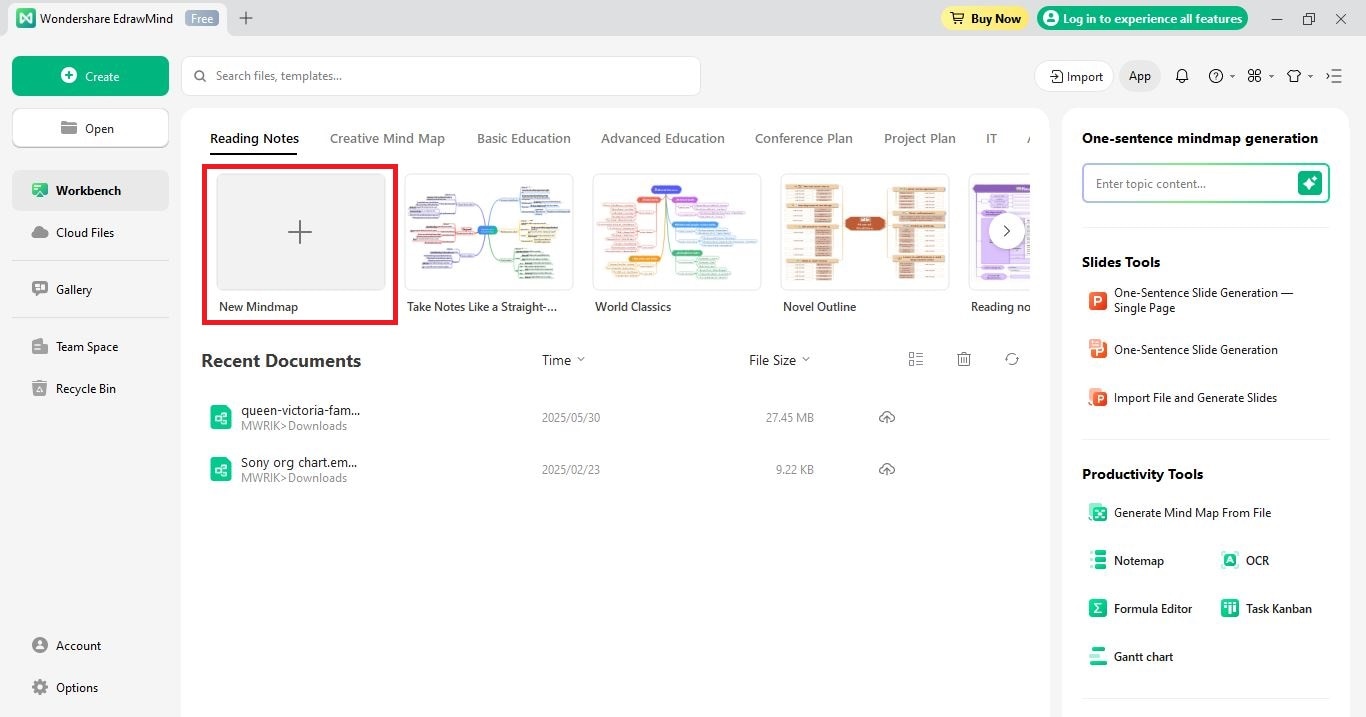
Step 2: Select the Timeline Layout
- Left-click the main idea and select Layout from the hovering menu.
- Under Timeline, choose the third layout for a vertical style.
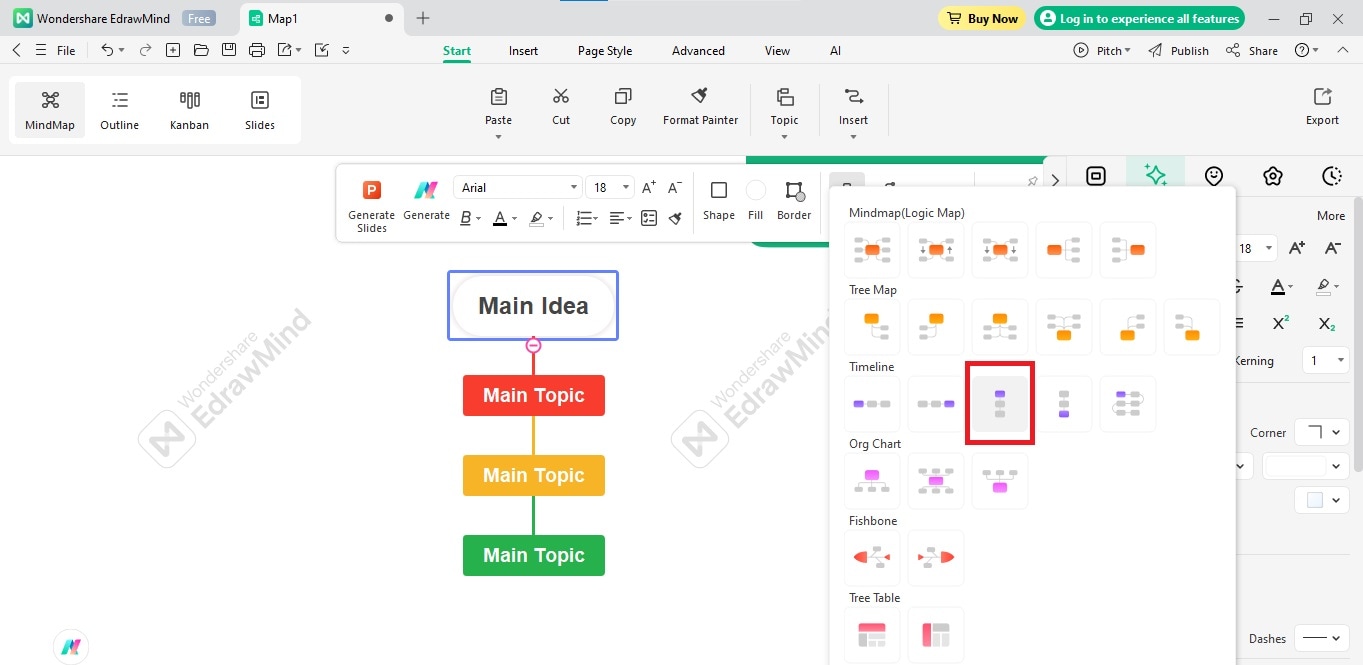
Step 3: Build Your Timeline
- In this step, we will add as many topics as needed and edit the text.
- To change the text, simply double-click it and type in your content.
- To add a node to your timeline, right-click the topic, go to Insert > Topic. From the below Topic, you can choose Subtopic if you want to add a child node horizontally.
- To remove a node, simply left-click it and press the Backspace key.
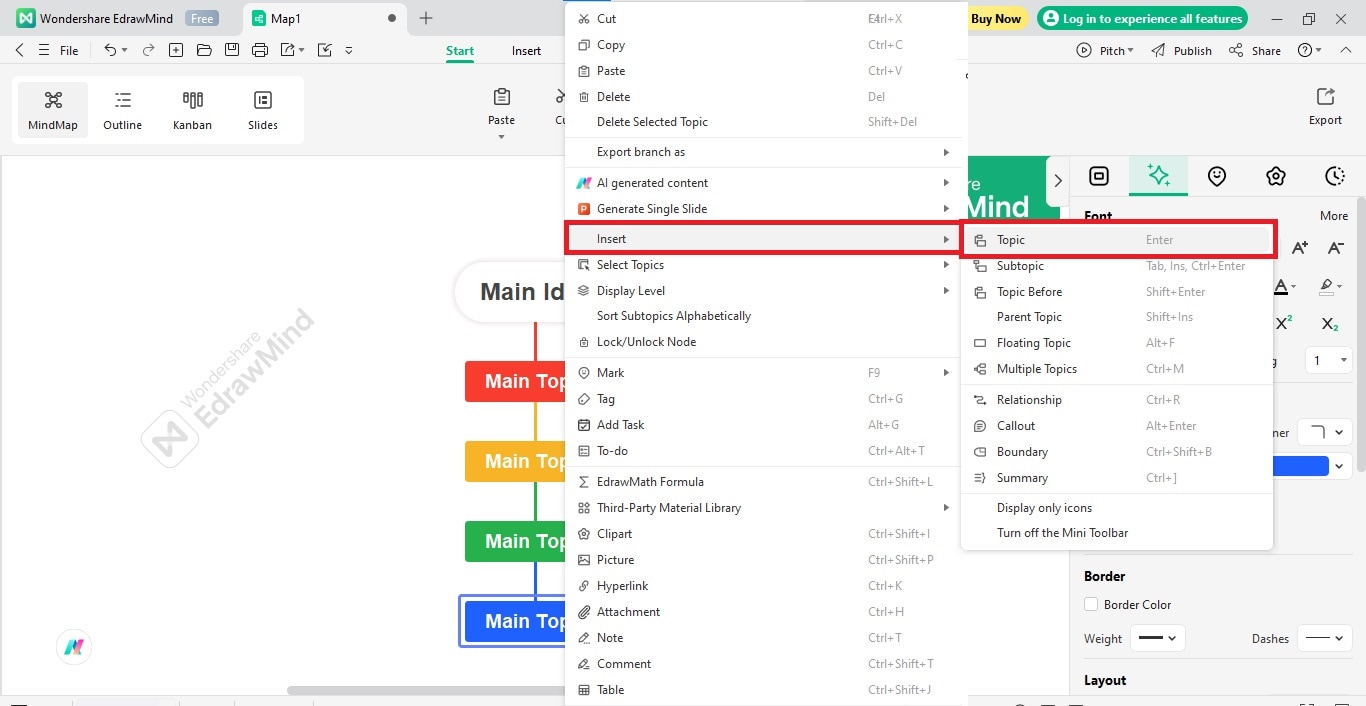
Step 4: Insert Images
- Images can be inserted in multiple ways. One method is to copy and paste a picture directly into EdrawMind.
- Another way is to right-click the topic in which you want to place the image and select Picture. Now just upload the photo from your computer and you'll be good to go.
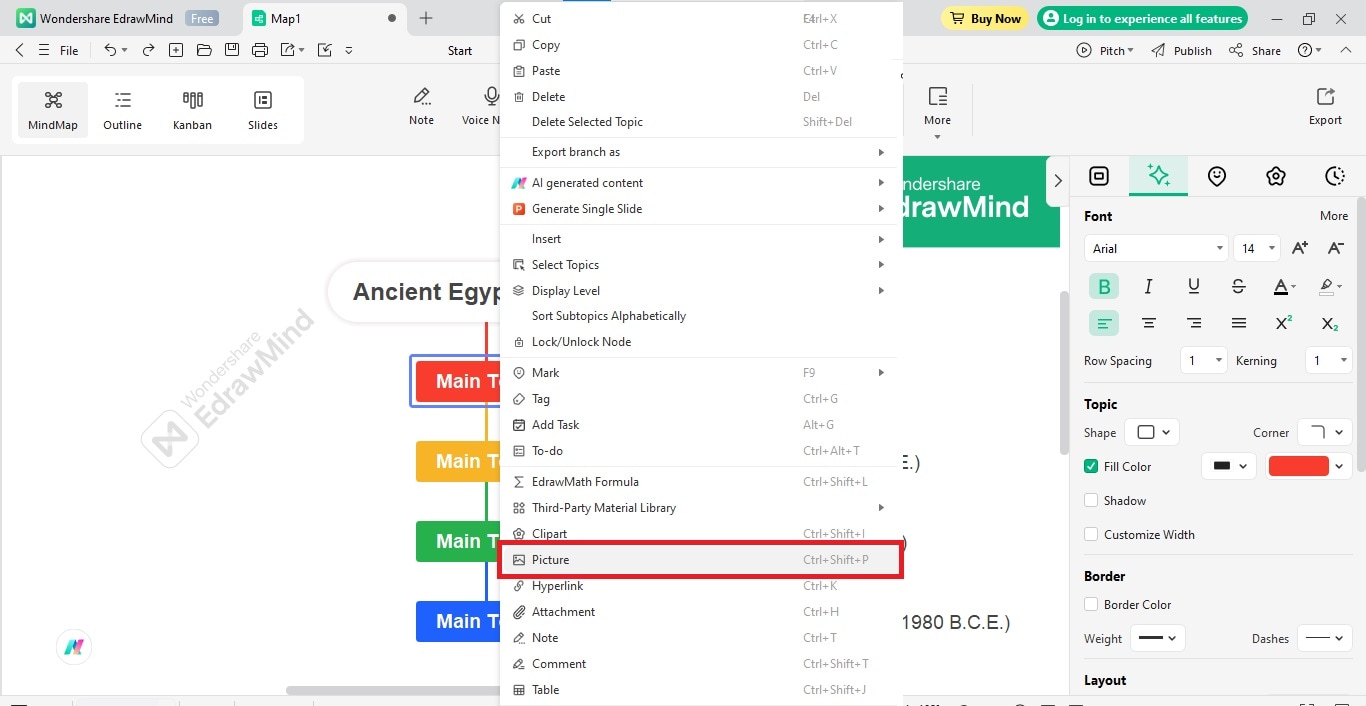
Step 5: Change the Theme
- If the default style doesn't match your timeline's theme, you can change it to one of the available pre-designed styles.
- Go to Theme style and click the dropdown menu to see available options. EdrawMind lets you create custom themes as well.
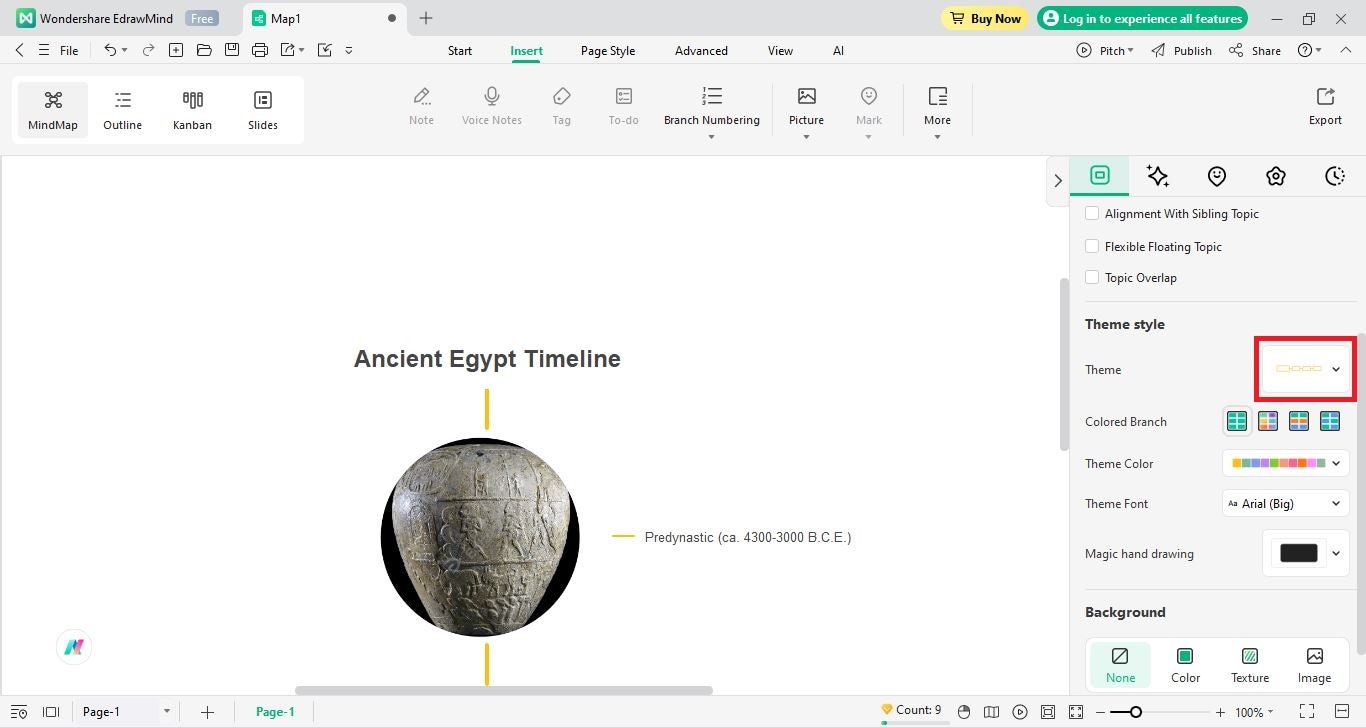
Step 6: Export Your Timeline
- Once you're happy with your design, you can download it by clicking the Export button in the top-right corner.
- Choose your preferred format. EdrawMind supports plenty of export formats, including JPG, PNG, PDF, HTML, SVG, and more. Finally, click the green Export button, and this will download the diagram to your computer.
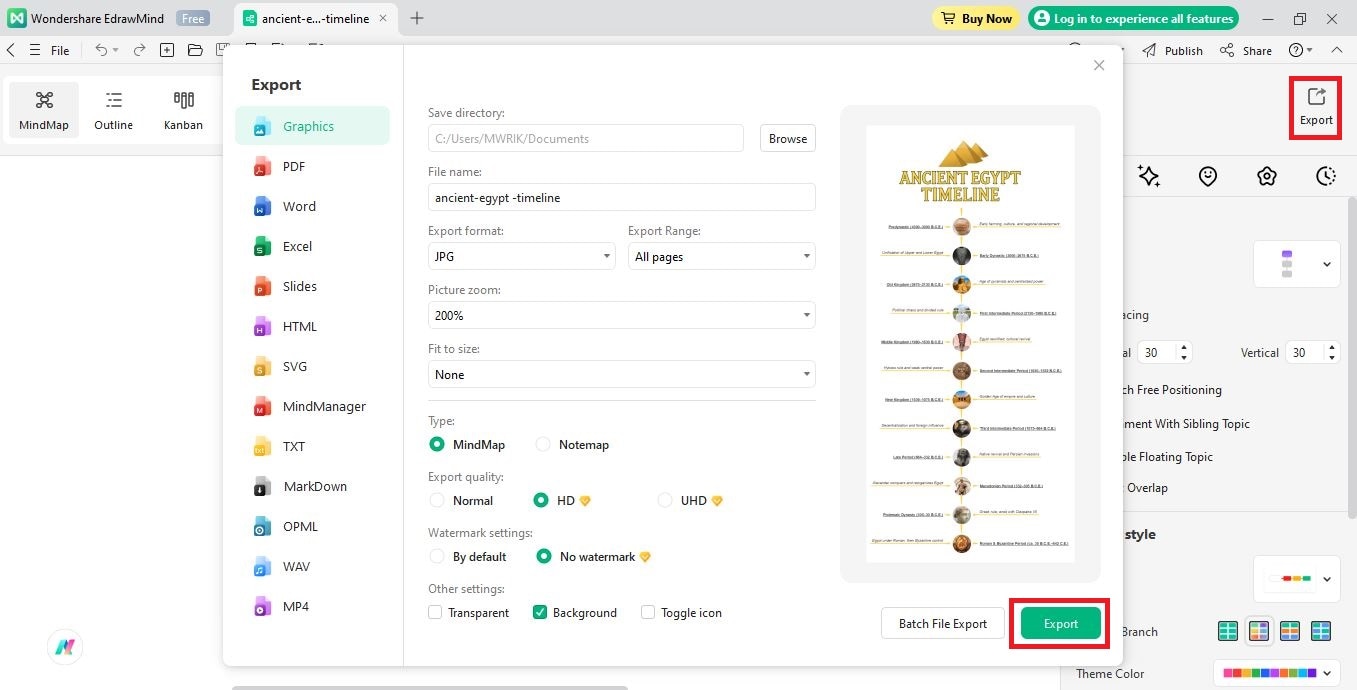
Final Thoughts
Ancient Egypt's history stretches across thousands of years. It is marked by powerful dynasties, technological and cultural advancements, foreign invasions, and political chaos. From predynastic settlements to the Byzantine Empire, each period shaped its legacy. This timeline simplifies this journey and many other events.
Loved the idea of making such timelines? EdrawMind could make this journey fun and easy. Try it out and share your country's history with the world!



